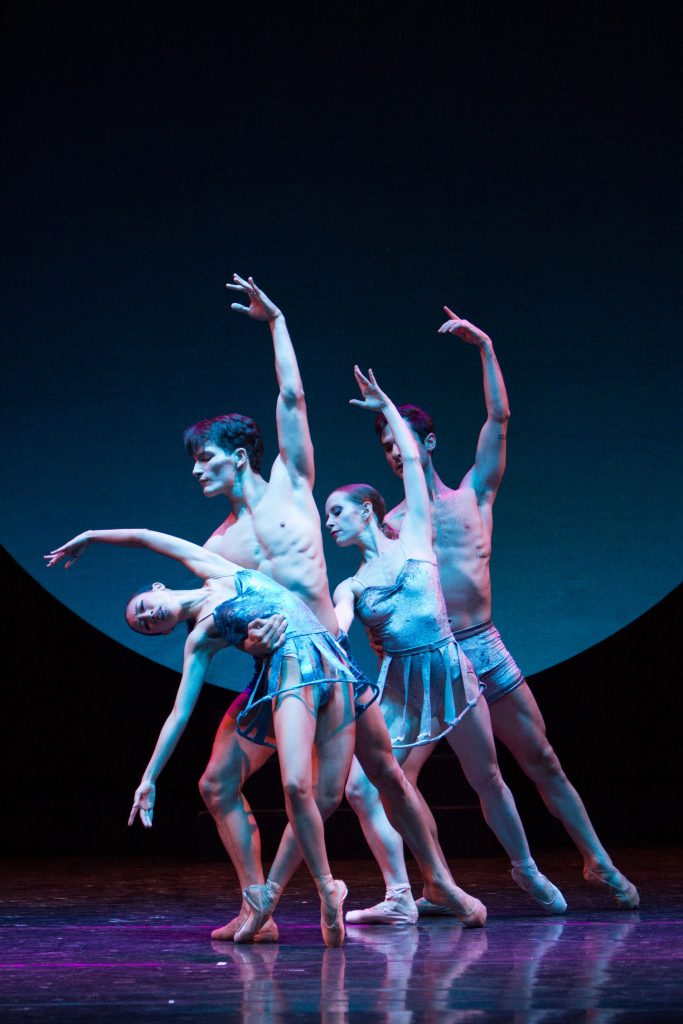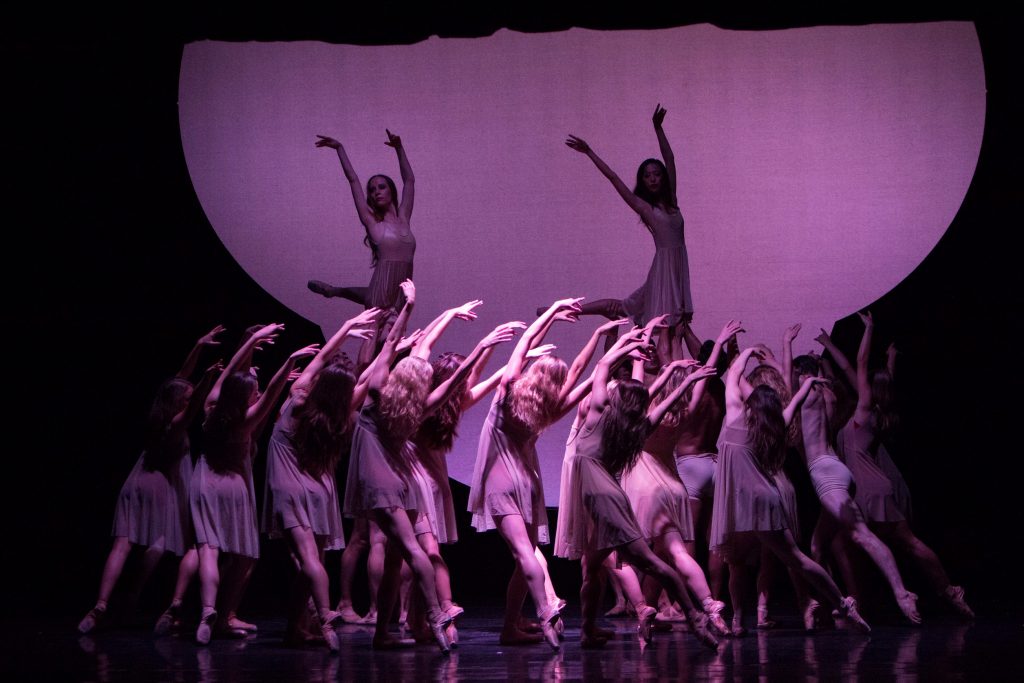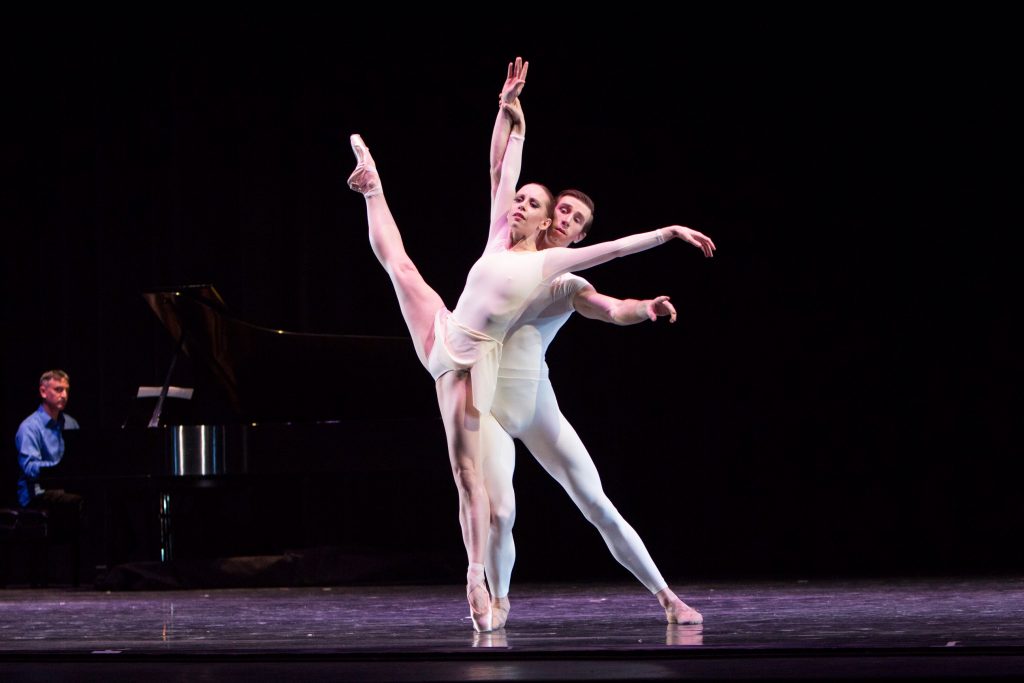Glorious Dance and Music in ‘Requiem’ Triple-Bill Marks City Ballet’s 26th Season
Three dances–set to soft piano, jarring snare drum beats, and a sacred mass–reminded us that life is good, and live performance is very good medicine.
The glorious dance and music in City Ballet of San Diego’s Mozart’s Requiem triple-bill production, with a full orchestra and 80-voice choir, was overwhelming, in a beautiful and emotional way.

Sumire Ito, Iago Breschi, Ariana Gonzalez, and Geoff Gonzalez are principals in “Requiem.” Image: Chelsea Penyak
When the curtain rose at the Spreckels Theatre last weekend (May 10-12), viewers were consumed with images and transcendent music that conjured loving couples and thoughts of approaching death, followed by joy.
City Ballet co-founder Elizabeth Wistrich returned with her emotionally charged ballet set to Mozart’s “Requiem Mass in D Minor,” and there was more emotion and urgency in the work, and even stronger performances than when it was presented it in 2014.
There were many striking performances. Principal dancers included: Ariana and Geoff Gonzalez, the daughter and son-in-law of Elizabeth and Steven Wistrich; ballerina Sumire Ito of Japan, and Iago Breschi of Brazil.
Dancers interpreted 12 sections of Mozart’s mass for the dead, and each section had a costume change and hue. Dancers walked in and out of a keyhole shape opening in the back of the stage, allowing dancers to enter from the wings and center stage. A scrim rising up and down suggested another dimension, but too often blurred our view of shirtless, god-like men in shiny skirts. They lifted women and balanced them on their thighs.
Movement and music were unified, and it was difficult to choose where to look. The Pacific Coast Chorale was a powerhouse in boxes on both sides of the theatre. There were a few pitch problems from a few singers, but none could diminish the brilliance of this work.
Wistrich interpreted the aching and solemn sections with stillness and had dancers walking on the shoulders of others, as if entering heaven. Stephen Judson’s lighting was bold and on cue.
Requiem is a mass for the dead. Mozart died before he could complete it in 1791, and his haunting score is provocative. In “Lacrimosa,” six men danced with exceptional power, and it was glorious to watch them dance as brothers and caring humans. Several viewers whispered that it reminded of them of loss, especially as this was Mother’s Day weekend. A few mentioned Notre Dame Cathedral being rebuilt, and rising from the ashes.
“Lacrimosa dies illa
Qua resurget ex favilla
Judicandus homo reus.
Huic ergo parce, Deus:
Pie Jesu Domine,
Dona eis requiem.That day of tears and mourning,
when from the ashes shall arise,
all humanity to be judged.
Spare us by your mercy, Lord,
gentle Lord Jesus,
grant them eternal rest.”The film Amadeus has a fictional ending, and there were rumors that he died of poisoning. But how did Mozart die tragically at the early age of 35?

City Ballet co-founder Elizabeth Wistrich choreographed the ballet “Requiem” in 2014. Image: Chelsea Penyak
Mozart’s Requiem remains a sacred mass for the dead, yet the ballet was hopeful and we found beauty in death, even on Mother’s Day weekend. Imagine how thrilling it is for City Ballet founders Steven and Elizabeth Wistrich to have their daughter and son-in-law dancing with commanding attention and grace in the company’s 26th season, and also creating world-class choreography.
The production opened with two works by Mr. Gonzalez, a restaging of fourPAIR, and Battu, a world premiere.

Ariana Gonzalez and Brian Heil dance to “Claire de Lune,” by Debussy. Pianist Mark Polesky is on stage. From the ballet fourPAIR. Image: Chelsea Penyak
The dancemaker Gonzalez explored relationships and partnering in fourPAIR, a work of four distinct and rewarding duets, set to Claude Debussy’s “Suite Bergamasque.” In the festive Prelude, dancers Sumire Ito and Iago Breschi mesmerized the large audience with chemistry and flirty spins. Both are quick and lean, and choreography by Gonzalez included gentle caresses. Ito cupped the back of her partner’s head, and he extended his hand to her. These simple gestures felt natural, and when they swirled into big lifts over the shoulder, it was magical.
The excellent pianist Mark Polesky, who wowed the crowd in City’s Balanchine production earlier this year, played the four movements on stage and was even more impressive this time around. He had a grand piano instead of an electric keyboard, and the dancers connected to him.
On Saturday night, Lucas Ataide and Rony Lenin had wonderful lines and mood in the medieval sounding “Passepied” section with hands flexed and silent landings.
Bethany Green and Megan Jacobs were fascinating characters in the “Menuet.” Dressed in pink, the tall and powerful women eyed each other and crisscrossed to explore the playful main theme and mysterious middle section.
Ariana Gonzalez and Brian Heil danced the familiar “Clair de Lune” section with exceptional musicality. Heil is more than an attentive partner, and we enjoyed every sliding sequence across the floor and hearing their deep breaths.
In Battu, one man and five women performed to the snare drum solo, “Tchik” by French percussionist Nicolas Martynciow. As drummer Adam Larocca pounded out rhythms from the choir box to our right, Ryosuke Ogura (alternating with Rony Lewis, Friday) led the ladies in youthful frolicking reminiscent of beach volleyball. The ladies flipped their ponytails and while expressions weren’t always in sync, it was a treat to watch Ogura break free from the typical ballet routine and fly in wild syncopation.
City Ballet of San Diego begins its 27th season with Carmina Burana, choreographed by Geoff Gonzalez, with Pacific Coast Chorale, Nov. 1-3, 2019. Also, Elizabeth Wistrich’s Straw Feet. www.cityballet.org.

Kris Eitland covers dance and theater for Sandiegostory.com and freelances for other publications, including the Union Tribune and Dance Teacher Magazine. She grew up performing many dance styles and continued intensive modern dance and choreography at the Univ. of Minnesota, Duluth, and San Diego State Univ. She also holds a journalism degree from SDSU. Her career includes stints in commercial and public radio news production.
Eitland has won numerous Excellence in Journalism awards for criticism and reporting from the San Diego Press Club. She has served on the Press Club board since 2011 and is a past president. She is a co-founder of Sandiegostory.com. She has a passion for the arts, throwing parties with dancing and singing, and cruising the Pacific in her family’s vintage trawler. She trains dogs, skis, and loves seasonal trips to her home state of Minnesota.
